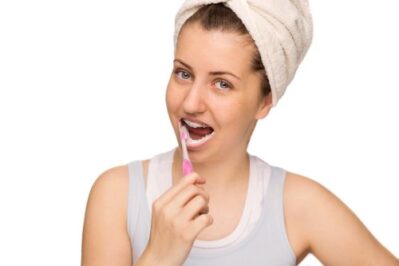How To Properly Take Care Of Your Smile & Braces
Orthodontic care is important and beneficial for both children and adults. Braces are often one important step in your oral health that goes beyond just aesthetics. Straight teeth help you bite, chew, and even speak more clearly. Straight teeth make it easier for you to brush and floss, helping you to maintain healthy gums and teeth.
When the topic of braces comes to mind, your first thought might be that of children and teens. However, braces for adults are quite common. In fact, anyone at any age can get braces. According to the Seton Hill University Center for Orthodontics, approximately 20 to 25 percent of orthodontics patients are adults.
Common reasons for orthodontic care in the form of braces include the following:
- Underbite
- Overbite
- Crossbite
- Teeth crowding
- Crooked smile
- Upper Front Teeth Protrusion
- Mismatched Dental Midlines (when your lower and upper jaws are not meeting properly)
Labbe Family Orthodontics recommends braces, such as Invisalign braces, to straighten a crooked smile, correct an abnormal bite, or fix any of the other above reasons. Not only do braces correct a bad bite, but they also result in you having a healthier mouth.
If you don’t have an orthodontic issue corrected, it can lead to further health complications such as:
- Gum disease
- Tooth decay
- Jaw problems
- Tooth loss
- Abnormal wear on your tooth enamel
- Affected chewing or speech
No matter what your reason is for wearing braces, an essential part of the experience is caring for them. The best orthodontist provides you with instructions on how to do this properly. When you take good care of your braces, they will be more effective and comfortable.
How To Take Care Of Your Braces
Caring for your teeth takes a little more effort when you have braces. With traditional braces, it’s easy for food to get trapped in countless tiny spaces and cause plaque buildup, which can lead to other dental problems. With adult invisible braces, however, the process is much easier, and we will discuss this in more detail below.
As an overview, there are certain oral care tips to properly tend to for adult orthodontics. These include the following:
- Brushing. Use a soft-bristled toothbrush and fluoride toothpaste to clean your teeth if you have braces.
- Flossing. It’s vital for you to carry out a daily flossing routine. Our orthodontist may recommend floss threaders or interdental brushes to get in between your teeth.
- Fluoride Mouthwash. Once you have brushed and flossed, rinse your mouth with a fluoride mouthwash. This helps prevent white spots and cavities.
More on Fluoride
Fluoride protects your teeth from tooth decay. Since braces can make it more difficult to clean your teeth thoroughly, your teeth are at risk of plaque accumulation, which can lead to the formation of cavities.
After every meal, brush your teeth with fluoride toothpaste. If you can’t brush after every meal, try to brush twice a day at a minimum. This will help keep your teeth free of decay. Fluoride helps your teeth resist the acids produced after you eat and drink. It also replaces lost minerals. Since wearing braces puts you at higher risk for tooth decay, you need all the protection you can get. For added protection, our orthodontist might even prescribe you additional fluoride products.
How To Take Care Of Your Invisalign Braces
Your Invisalign orthodontist custom makes clear aligners just for you. These aligners fit snugly over your teeth and are virtually invisible. Each
aligner slightly shifts your teeth, moving them vertically and horizontally, and it even rotates them as needed. They are designed to extend the proper amount of force at the right time in the right place.
Generally, you change to another set of aligners each week as your teeth gradually move into position. The whole process is precisely mapped out by your orthodontist. As mentioned above, oral care gets a whole lot easier with Invisalign braces in comparison to traditional braces.
- Maintain oral hygiene. You can easily remove your aligners for normal brushing and flossing. To make it easier to clean your aligners, you can use a specially-designed Invisalign cleaning kit.
- Embrace simple cleaning. You can maintain nearly the same bedtime teeth cleaning routine that you had before getting Invisalign braces. The only difference is that you have to clean your aligners in addition to your teeth. But, there is no time-consuming struggle of brushing and flossing between wires and brackets. You just take the aligners out and brush.
Daily To-do-list For Caring For Your Invisalign Braces
It’s fairly simple to care for your adult invisible braces. Some daily steps to take include the following:
- Remove and rinse your aligners to eliminate plaque and dry saliva. Plaque and saliva can create an ideal breeding ground for bacteria.
- Use the Invisalign cleaning crystals or denture cleaner to clean and sanitize your trays.
- Brush and floss your teeth before reinserting your aligners. Because your Invisalign is form-fitting, if you don’t brush and floss correctly, you risk trapping harmful particles in your aligner and between your teeth, which can cause decay and cavities. Use an anti-bacterial clear soap to clean your aligners to keep them fresh, clean, and bacteria-free.
- Be gentle when brushing your aligners. Brushing them vigorously can scratch them and leave visible etchings.
- Use an anti-bacterial clear soap to clean your Invisalign tray to keep it clean and bacteria-free. If you use toothpaste to clean your tray, it can turn yellowish in color. Because toothpaste contains ingredients that are abrasive, it can also cause odor and build-up.
What Not To Eat When You Have Braces
You need to be cautious of what you eat when you wear braces, and that includes your Invisalign braces. When you eat foods that are starchy and sugary, plaque can form, which causes cavities, gum disease, and stained teeth. Avoid chewy or sticky foods like taffy, caramel, dried fruits, and corn on the cob as they can get stuck in your braces and become difficult to remove.
Avoid drinking hot beverages when you are wearing your aligners–always remove them first. Your aligners contain a plastic resin, which can become distorted and damaged by heat. Avoid chewing gum, too. You shouldn’t be chewing anything while wearing your clear braces since you risk cracking, breaking, or distorting them.
Colored drinks can also temporarily change the color under your ceramic braces. Beverages like red wine, coffee, and tea can stain them. Therefore, if you are an avid coffee drinker in the morning, remember to remove your clear braces and brush your teeth before you put them back in.
Friendly Diets For You And Your Braces
The good news is that with clear braces, you can remove them before you eat. This allows you to enjoy eating all the foods you love with no restrictions or concern about getting food caught in the brackets and wires of traditional braces. Just take your aligners out and enjoy eating.
However, even with Invisalign braces, eating a healthy, balanced diet is still essential not only for the health of your body but also for the health of your teeth. A friendly diet can include soft vegetables and lean protein, like chicken and fish. You can even splurge on your favorite dessert as long as you brush your teeth afterward.
How To Take Care Of Your Smile After Your Adult Invisible Braces
Our Invisalign orthodontist checks and tracks the positioning of your teeth at every visit to determine when your treatment is complete. You did what you had to do to get that perfectly straight smile. You cared for your teeth and aligner trays, and now your treatment is complete. But to keep that beautiful smile, you still need proper oral care. Here are some areas to focus on.
Wear your retainer. Even with Invisalign, our orthodontist might still recommend wearing a retainer to prevent your teeth from gradually shifting back into their initial position.
Our orthodontist will usually be the one to fabricate your retainer. He or she will take an impression or mold of your new, straight teeth and create your retainer out of either an acrylic material or wire. Once the lab has created your retainer, you’ll come in for an appointment and have it inserted. Retainers can be worn for years, if not indefinitely.
There are two main types of retainers that you can wear after you have completed your braces treatment: removable and fixed. Your clinical needs will determine which one is right for your individual case.
Avoid certain foods. It’s a good idea to continue avoiding foods that are hard, crunchy, or difficult to chew. After treatment, your teeth go through an adjustment period and could be more sensitive.
Brush and floss daily. You still need to brush and floss your teeth regularly to avoid cavities, decay, and other dental issues. You should also rinse with a fluoride mouthwash or just warm water and salt.
Consider teeth whitening. Now that your teeth are nice and straight, you can enhance that smile of yours even more by whitening your teeth. This will help to get rid of or avoid discoloration or stains.
Maintain regular dental checkups. Regular dental checkups are still important. You will need x-rays and professional cleanings to ensure your teeth and gums remain healthy and strong. If problems such as cavities are detected, it’s essential that they are taken care of right away.
Working with our orthodontist for braces helped you get that perfectly straight set of teeth. It’s now your turn to keep them that way.
If you haven’t straightened your teeth yet and need to, find an orthodontist at Labbe Family Orthodontics (locations in Annapolis, Bowie, Crofton, and Greenbelt) to discuss your options including Invisalign clear braces.
Source
- http://www.mouthhealthy.org/en/az-topics/b/braces
- http://www.shape.com/lifestyle/beauty-style/10-invisalign-truths-know-you-try
- https://www.invisalign.com/frequently-asked-questions
- http://www.colgate.com/en/us/oc/oral-health/cosmetic-dentistry/adult-orthodontics/article/caring-for-braces-you-are-on-your-way-to-a-healthy-smile-0414
- http://www.colgate.com/en/us/oc/oral-health/cosmetic-dentistry/adult-orthodontics/article/tips-for-adults-with-braces-0314
- https://www.colgateprofessional.com/patient-education/articles/protecting-your-healthy-smile-while-wearing-braces
- http://www.colgate.com/en/us/oc/oral-health/cosmetic-dentistry/early-orthodontics/article/retainers-after-braces-types-and-maintenance-0414
- http://www.colgate.com/en/us/oc/oral-health/cosmetic-dentistry/adult-orthodontics/article/adult-braces-before-and-after-what-to-expect-when-they-come-off-0714
- https://www.invisalign.com/how-invisalign-works/living-with-invisalign




